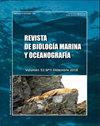Uso de organismos intermareales del litoral rocoso como bio-indicadores de deformación continental cosísmica en el centro sur de Chile
IF 0.5
4区 生物学
Q4 MARINE & FRESHWATER BIOLOGY
引用次数: 1
Abstract
espanolResumen: El 27 de febrero de 2010, la zona centro-sur de Chile (ca., 34-39oS) fue afectada por un terremoto de magnitud Mw= 8,8, localizandose el epicentro en Cobquecura (ca., 36oS), causando un levantamiento continental en las costas mas cercanas a la fosa (i.e., Peninsula de Arauco e Isla Santa Maria) y subsidencia en areas costeras localizadas al norte de esas costas (Region del Maule). En este estudio se evaluo la hipotesis de que independientemente del grupo taxonomico, los organismos bentonicos intermareales adheridos al sustrato pueden ser utilizados como indicadores de levantamiento cosismico continental. La metodologia consistio en medir la altura del limite superior de las bandas de distribucion de cada especie sobre el nivel de marea baja, a lo largo de la costa afectada por el terremoto. El alga calcarea Lithothamnium sp., el mitilido Perumytilus purpuratus y las macroalgas Mazzaella laminarioides y Lessonia spicata, son organismos bentonicos apropiados para describir el levantamiento continental cosismico. Se sugiere que en estudios tendientes a evaluar este tipo de procesos tectonicos, se utilice mas de una especie para tener una vision completa de tal proceso a lo largo de gradientes de deformacion continental. Esto ya que, parte importante de las especies bentonicas de la costa rocosa no tienen distribucion continua, por lo que el uso de una sola especie puede resultar en conclusiones con bajo nivel de generalizacion. EnglishAbstract: On February 27, 2010, the south central coast of Chile (ca., 34-39oS) was affected by an earthquake magnitude Mw= 8,8, with the epicenter located offshore Cobquecura (ca., 36.29oS). This earthquake originated continental uplift on that coastal areas closer to the trench between the Nazca and South American tectonic plates (i.e., Peninsula de Arauco and Isla Santa Maria) and subsidence along coastal areas located further north of that (the coast of the Maule Region), as well as in continental zones ordered in a west - east axis. In this study we tested the hypothesis that independent of the taxonomic group, the rocky shore sessile benthic organisms can be used as indicators of continental uplift. The methodology involved measurements of heights upper of distributional bands above the low tide level at the coast affected by the earthquake. The results show that the calcareous crustose algae Lithothamnium sp., the mytilid bivalve Perumytilus purpuratus and the macroalgae Mazzaella laminarioides and Lessonia spicata, are benthonic useful organisms to describe continental uplift, due to the fact that their vertical distributions after the earthquake follow the coastal deformation observed in the field. This allow to suggest that in studies aimed to evaluate this tectonic processes, more than a single species must be used in order to gain a full view of that along gradients of continental deformation. This due to the fact that a significant number of the benthic species of the rocky shore do not have continuous distribution; thus, to use a single species may well result in conclusions with low level of generalizations.利用岩石海岸潮间带生物作为智利中南部同震大陆变形的生物指标
西班牙摘要:2010年2月27日,智利中南部地区(约34-39oS)发生了一场Mw=8.8级地震,震中位于科布库拉(约36 oS),在离火山口最近的海岸(即阿劳科半岛和圣玛丽亚岛)引发了大陆起义,并在这些海岸以北的沿海地区(毛勒地区)发生了沉降。这项研究评估了这样一种假设,即无论分类群如何,附着在基质上的潮间带膨润土生物都可以用作大陆同震隆升的指标。该方法包括测量受地震影响的海岸线上每种物种在低潮位上分布带的上限高度。Calcarea Lithothamnium sp.、Mitilido Perumytillus purpuratus和Mazzaella laminarioides大型藻类和Lessonia spicata是描述同震大陆隆升的合适膨润土生物。建议在评估这类构造过程的研究中,使用一个以上的物种来沿着大陆变形梯度全面了解这一过程。这是因为,岩石海岸的大部分膨润土物种没有连续分布,因此使用单一物种可能会得出普遍程度较低的结论。Englishabstract:2010年2月27日,智利中南海岸(约34-39oS)受到地震Mw=8.8的影响,震中位于离岸Cobquecura(约3629oS)。这场地震起源于纳斯卡和南美构造板块(即阿劳科半岛和圣玛丽亚岛)之间的海沟附近的沿海地区的大陆隆升,以及位于该海沟以北的沿海地区(毛乌科海岸和圣玛丽亚岛)的沉降。Le地区),以及在东西轴有序的大陆地区。在这项研究中,我们测试了独立于分类群的假设,即岩岸Sessile底栖生物可以用作大陆隆升的指标。该方法涉及测量受地震影响海岸低潮以上分布带的高度。结果表明,由于地震后它们的垂直分布遵循现场观察到的海岸变形,钙质甲壳类动物藻类Lithothamnium sp.、Mytilid bivalus perumytillus purpuratus和大型藻类Mazzaella laminarioides和Lessonia spicata是描述大陆隆升的有用底栖生物。这表明,在旨在评估这一构造过程的研究中,必须使用一个以上的物种,才能沿着大陆变形的梯度全面了解这一点。这是因为岩岸的大量底栖物种没有连续分布;因此,使用单一物种可能会导致泛化程度较低的结论。
本文章由计算机程序翻译,如有差异,请以英文原文为准。
求助全文
约1分钟内获得全文
求助全文
来源期刊
CiteScore
0.70
自引率
0.00%
发文量
41
审稿时长
12 months
期刊介绍:
Publicar desde una perspectiva científica, artículos originales, decididos por un proceso de revisión por pares, invitando a expertos de reconocido prestigio en el área. Los trabajos publicados se caracterizarán por su solidez teórica-metodológica, actualidad y relevancia para las ciencias marinas.
Se reciben trabajos inéditos derivados de la investigación científica realizada en ambientes marinos y estuarios, en formato de Revisión, Artículos, Notas Científicas, y Obituarios en las siguientes disciplinas::
Biología-Ecología marina
Oceanografía física, química y biológica
Contaminación marina
Geología marina
Sistemática, Faunística y Biogeografía Marina
Manejo Costero
Acuicultura marina
Pesquería marina.

 求助内容:
求助内容: 应助结果提醒方式:
应助结果提醒方式:


